A History of Gold Dredging in Idaho
Mining the American West
Duane A. Smith, Robert A. Trennert, and Liping Zhu, editors
Boomtown Blues: Colorado Oil Shale, Andrew Gulliford
From Redstone to Ludlow: John Cleveland Osgoods Struggle against the United Mine Workers of America, F. Darrell Munsell
Gambling on Ore: The Nature of Metal Mining in the United States, 18601910, Kent A. Curtis
Hard as the Rock Itself: Place and Identity in the American Mining Town, David Robertson
High Altitude Energy: A History of Fossil Fuels in Colorado, Lee Scamehorn
A History of Gold Dredging in Idaho, Clark C. Spence
Industrializing the Rockies: Growth, Competition, and Turmoil in the Coalfields of Colorado and Wyoming, David A. Wolff
The Mechanics of Optimism: Mining Companies, Technology, and the Hot Spring Gold Rush, Montana Territory, 18641868, Jeffrey J. Safford
Mercury and the Making of California: Mining, Landscape, and Race, 18401890, Andrew Scott Johnston
The Rise of the Silver Queen: Georgetown, Colorado, 18591896, Liston E. Leyendecker, Duane A. Smith, and Christine A. Bradley
Santa Rita del Cobre: A Copper Mining Community in New Mexico, Christopher J. Huggard and Terrence M. Humble
Silver Saga: The Story of Caribou, Colorado, Revised Edition, Duane A. Smith
Thomas F. Walsh: Progressive Businessman and Colorado Mining Tycoon, John Stewart
Yellowcake Towns: Uranium Mining Communities in the American West, Michael A. Amundson
A History of Gold Dredging in Idaho
Clark C. Spence
University Press of Colorado
Boulder
2016 by University Press of Colorado
Published by University Press of Colorado
5589 Arapahoe Avenue, Suite 206C
Boulder, Colorado 80303
All rights reserved
Printed in the United States of America
 The University Press of Colorado is a proud member of Association of American University Presses.
The University Press of Colorado is a proud member of Association of American University Presses.
The University Press of Colorado is a cooperative publishing enterprise supported, in part, by Adams State University, Colorado State University, Fort Lewis College, Metropolitan State University of Denver, Regis University, University of Colorado, University of Northern Colorado, Utah State University, and Western State Colorado University.
This paper meets the requirements of the ANSI/NISO Z39.481992 (Permanence of Paper).
ISBN: 978-1-60732-474-4 (cloth)
ISBN: 978-1-60732-475-1 (e-book)
Library of Congress Cataloging-in-Publication Data
Spence, Clark C.
A history of gold dredging in Idaho / Clark C. Spence.
pages cm
Includes bibliographical references.
ISBN 978-1-60732-474-4 (cloth) ISBN 978-1-60732-475-1 (ebook)
1. Gold mines and miningIdahoHistory. 2. Placer miningIdahoHistory. I. Title.
TN413.I2S64 2016
622'.342209796dc23
2015033570
Cover photograph: the Boston and Idaho Companys fifteen-foot bucket dredge, courtesy, Idaho State Historical Society, Boise, ISHS 72-112.b.
For Judith Austin
Acknowledgments
I owe a debt of gratitude to the staffs of several major libraries, especially the University of Illinois, as well as the Huntington and the Bancroft Libraries in California, and to a number of individuals and organizations. Alan Virta of Special Collections, Boise State University, provided pertinent documents from the Paul Tracy papers, and Lorna Tracy, Pauls daughter, approved usage of the text from her home in England. Cindy Schacher, an archaeologist with the Nez PerceClearwater Forest Service, sent important letters and books on dredging. Edgar Rice Burroughs, Inc., a California concern, furnished three rare late-nineteenth-century dredge icons. Jamie Edmondson, spokesperson for the Idaho Gold Fields Historical Society, Smith Collection, came up with a hard-to-find photograph of a dragline dredge. As director of the Lemhi County Historical Society and Museum in Salmon, Hope Benedict went beyond the call of duty and was able to provide several very striking pictures. At the Idaho State Historical Society in Boise, the busy work staff was responsible for digitally copying a wide range of dredge-related photos, with Layce Johnson handling the orders and seeing them to their destination. Judith Austin was a key figure in helping select these photos. Without her help, this book would not have been possible. Finally, hats off to the staff of the University Press of Colorado for their expertise, patience, and understanding. Specifically, Jessica dArbonne has been the ideal editor.
A History of Gold Dredging in Idaho
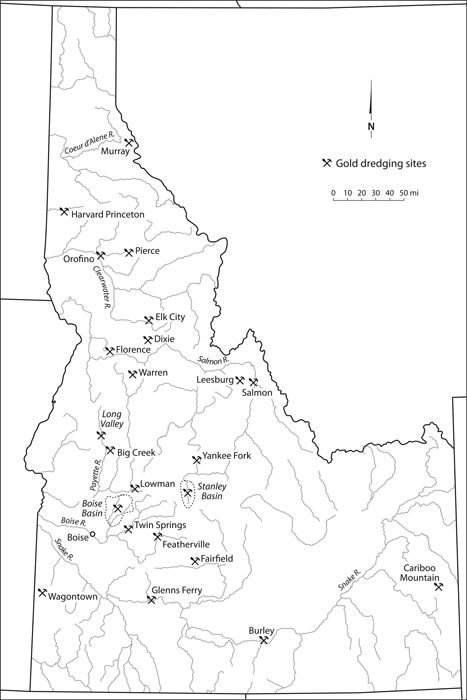
Major gold dredging sites in Idaho. Map by Bill Nelson.
Introduction
Gold is where you find it, is an old mining saying. Whenever it is found, it appears in its natural form in two different ways, depending on the geologic environment. One form is in hard-rock lode deposits, deposits that may have had different origins but which remain locked within the original solid rock formations. Even if a lucky prospector located a so-called quartz mine, it was clear that development was for corporate, not individual, effort and might take years before it returned a profit. The work called for more and more capital for tunneling, timbering blasting ore, transporting it underground, and hoisting it to the surface. Moreover, gold in hard-rock ores was often difficult to removerefractory in the language of the engineers. In the worst cases, it might be in combination with other elements, which meant more intricate and costly processes would be needed. These kinds of deposits have produced the bulk of the worlds gold to date.
The second type is the secondary deposit, which occurs in several forms. Residual deposits are usually found where rocks have weathered and deteriorated, but without water. They have not yet been washed away, nor have
From ancient times, such placer deposits were easier to find and work than lode mines, and more than one technique would carry over into early gold mining in the American West. The panning of gold was the simplest way for the prospector to test for placer gold. The early Romans had used a pan of some sort for that purpose, and widespread usage continued through the ages. By the time Californians brought it to Idaho, the pan had become standardized in sheet iron, eighteen inches in diameter and four inches deep, with sides slanting outward at an angle of thirty-seven degrees. Fortunately for the early comers, gold was plentiful and easily panned in the early days of all of Idahos high-country placersPierce, Florence, Elk City, Warren, Salmon City, Stanley Basin, Boise Basin, and on the South and Middle Forks of the Boise River.
The rocker or cradle was a considerable improvement over the pan. This was a rectangular box, set at a downward angle and mounted on a rocking mechanism like that of a rocking chair. At the top was a removable hopper with a mesh screen or perforated iron plate; at the bottom was a series of cleats or riffles. The gravel was dumped into the top, followed by a bucket of water, after which the cradle was rocked by hand to agitate the mixture. Any rocks were caught by the screen or perforated plate; the smaller wasted
The machine was an advancement over the sluice, which in its most primitive form was simply a long ditch with its bottom cleated with rocks, gravel, and holes to act as riffle bars; more often it took the shape of a long tom. Built of wood, the latter was ten feet to twenty feet long, a foot-and-a-half deep, and tapered at one end so that a number of them might be fitted together to form a sluice sometimes several hundred feet long. The lower end of the long tom, called the riddle, replaced the hopper of the cradle, and a heavily perforated iron strained out the large debris while allowing water and small gravel to fall into a riffle box where the gold was captured. Widely used throughout the West, such equipment needed an available running stream of water, which was usually supplied by running a flume from a nearby river or creek.

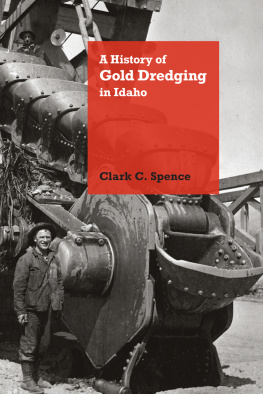
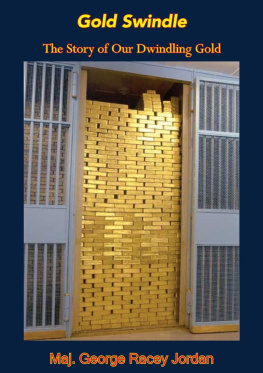

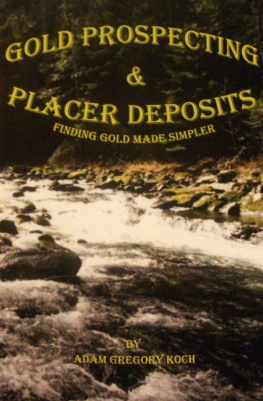
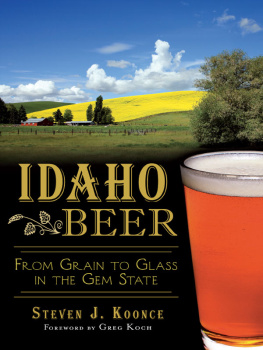


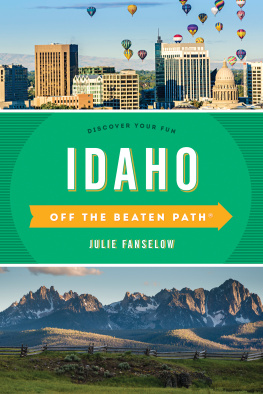
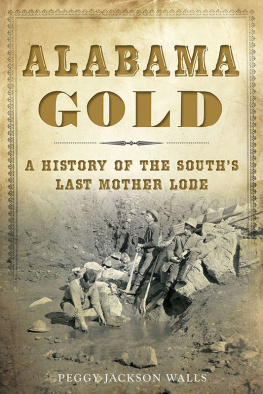
 The University Press of Colorado is a proud member of Association of American University Presses.
The University Press of Colorado is a proud member of Association of American University Presses.